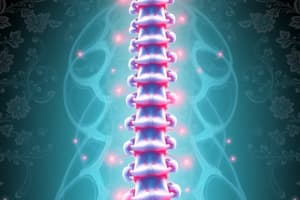Podcast
Questions and Answers
What is the characteristic feature of an antalgic gait?
What is the characteristic feature of an antalgic gait?
- Walking as if there were a thorn in the sole of the foot (correct)
- Limited range of motion and avoidance of weight-bearing
- Fixed ankle position while lifting and lowering the foot
- Unconscious adaptive trunk shift during stance phase
In patients with hip pain, what is the typical trunk movement during the stance phase on the affected leg?
In patients with hip pain, what is the typical trunk movement during the stance phase on the affected leg?
- Shift away from the affected side
- Shift towards the affected side (correct)
- Conscious elevation of the foot
- Unconscious fixing of the ankle position
What distinguishes coxalgic gait from waddling gait caused by gluteus medius muscle weakness?
What distinguishes coxalgic gait from waddling gait caused by gluteus medius muscle weakness?
- Fixed ankle position while lifting and lowering the foot
- Contralateral hemipelvis dropping during the stance phase (correct)
- Unconscious trunk shift towards the affected side
- Conscious elevation of the foot to reduce load
Which condition may cause painful lower extremities resulting in an antalgic gait?
Which condition may cause painful lower extremities resulting in an antalgic gait?
What is the main treatment approach for spastic paraparetic gait?
What is the main treatment approach for spastic paraparetic gait?
What is a characteristic feature of spastic paraparetic gait?
What is a characteristic feature of spastic paraparetic gait?
In cases of marked muscle tone in the adductors, what type of gait disorder may result?
In cases of marked muscle tone in the adductors, what type of gait disorder may result?
Which medication may be used to help alleviate spasticity in spastic paraparetic gait?
Which medication may be used to help alleviate spasticity in spastic paraparetic gait?
What distinguishes sensory ataxia from cerebellar ataxia?
What distinguishes sensory ataxia from cerebellar ataxia?
What type of gait may be observed in cerebellar ataxia?
What type of gait may be observed in cerebellar ataxia?
Which region of the cerebellum is predominantly responsible for the control of balance?
Which region of the cerebellum is predominantly responsible for the control of balance?
What type of disturbances may occur in sensory polyneuropathy or dorsal column lesions?
What type of disturbances may occur in sensory polyneuropathy or dorsal column lesions?
What type of compensation do patients with sensory ataxic gait use for the loss of proprioception?
What type of compensation do patients with sensory ataxic gait use for the loss of proprioception?
Which test may reveal less difference in cerebellar ataxia compared to sensory ataxia?
Which test may reveal less difference in cerebellar ataxia compared to sensory ataxia?
What may cause a worsening of ataxic gait and the associated risk of falling in sensory ataxia?
What may cause a worsening of ataxic gait and the associated risk of falling in sensory ataxia?
Which region of the cerebellum is important for the control of the timing and amplitude of targeted limb movements?
Which region of the cerebellum is important for the control of the timing and amplitude of targeted limb movements?
Which type of gait disorder is characterized by an excessive fear of falling, leading to a complete inability to walk?
Which type of gait disorder is characterized by an excessive fear of falling, leading to a complete inability to walk?
What type of gait disorder is mainly characterized by a stiff and paraparetic spastic gait, but may also be spastic-ataxic due to dorsal column dysfunction?
What type of gait disorder is mainly characterized by a stiff and paraparetic spastic gait, but may also be spastic-ataxic due to dorsal column dysfunction?
What non-surgical treatment includes training how to lift the pelvis while standing and walking or corsets to counteract lumbar lordosis?
What non-surgical treatment includes training how to lift the pelvis while standing and walking or corsets to counteract lumbar lordosis?
In which type of gait disorder should surgical decompression be considered in symptomatic cases due to its progressive nature?
In which type of gait disorder should surgical decompression be considered in symptomatic cases due to its progressive nature?
Which type of gait disorder is characterized by a dominance of the tonus in the upper limb flexor muscles and a slow, wide-based, asymmetrical gait?
Which type of gait disorder is characterized by a dominance of the tonus in the upper limb flexor muscles and a slow, wide-based, asymmetrical gait?
What type of gait disorder is mainly caused by narrowing of the spinal canal and mechanical compression of the cervical spinal cord?
What type of gait disorder is mainly caused by narrowing of the spinal canal and mechanical compression of the cervical spinal cord?
Which type of gait disorder is associated with deep muscular pain and neurological deficits such as sensory deficits and paresis in the lower limbs during walking?
Which type of gait disorder is associated with deep muscular pain and neurological deficits such as sensory deficits and paresis in the lower limbs during walking?
What type of non-surgical treatment may include corsets to counteract lumbar lordosis for certain types of gait disorders?
What type of non-surgical treatment may include corsets to counteract lumbar lordosis for certain types of gait disorders?
In which type of gait disorder should walking uphill be better tolerated than walking downhill?
In which type of gait disorder should walking uphill be better tolerated than walking downhill?
Which type of gait disorder typically presents with urinary urgency in severe cases?
Which type of gait disorder typically presents with urinary urgency in severe cases?
What non-surgical treatment includes training on how to lift the pelvis while standing and walking for certain types of gait disorders?
What non-surgical treatment includes training on how to lift the pelvis while standing and walking for certain types of gait disorders?
In which type of gait disorder is walking uphill better tolerated than walking downhill due to the associated symptoms?
In which type of gait disorder is walking uphill better tolerated than walking downhill due to the associated symptoms?
What is the result of thickening of the ligamentum flavum and a decrease in the gap between the posterior margin of the intervertebral disc and the facet joints?
What is the result of thickening of the ligamentum flavum and a decrease in the gap between the posterior margin of the intervertebral disc and the facet joints?
What is a common cause of knee hyperextension during the early stance phase?
What is a common cause of knee hyperextension during the early stance phase?
In patients with differences in leg length, how does the body move with each step?
In patients with differences in leg length, how does the body move with each step?
What is a characteristic gait pattern in patients with myopathies affecting the muscles extending the hip joint?
What is a characteristic gait pattern in patients with myopathies affecting the muscles extending the hip joint?
What is a common feature of steppage gait?
What is a common feature of steppage gait?
What is a symptom of intermittent claudication?
What is a symptom of intermittent claudication?
What is a characteristic symptom of lumbar spinal stenosis and neurogenic claudication?
What is a characteristic symptom of lumbar spinal stenosis and neurogenic claudication?
What does kyphosis and ankylosing spondylitis result in?
What does kyphosis and ankylosing spondylitis result in?
What is a characteristic feature of waddling gait caused by weakness in the gluteus medius muscle?
What is a characteristic feature of waddling gait caused by weakness in the gluteus medius muscle?
What is a common cause of peripheral paresis that leads to gait disorders?
What is a common cause of peripheral paresis that leads to gait disorders?
How do patients with spinal pain typically modify their gait?
How do patients with spinal pain typically modify their gait?
What leads to an instability of the pelvis on standing and walking, resulting in a characteristic waddling gait?
What leads to an instability of the pelvis on standing and walking, resulting in a characteristic waddling gait?
Flashcards
Antalgic gait
Antalgic gait
Walking with a limp, as if there was a thorn in the sole of the foot.
Trunk movement in hip pain
Trunk movement in hip pain
The body shifts toward the side with hip pain during the stance phase.
What distinguishes coxalgic gait?
What distinguishes coxalgic gait?
The contralateral pelvis drops during the stance phase, unlike in gluteus medius muscle weakness.
Cause of antalgic gait
Cause of antalgic gait
Signup and view all the flashcards
Treatment of spastic paraparetic gait
Treatment of spastic paraparetic gait
Signup and view all the flashcards
Characteristic of spastic paraparetic gait
Characteristic of spastic paraparetic gait
Signup and view all the flashcards
Gait disorder from adductor tone
Gait disorder from adductor tone
Signup and view all the flashcards
Medication for spastic paraparetic gait
Medication for spastic paraparetic gait
Signup and view all the flashcards
Differentiating sensory and cerebellar ataxia
Differentiating sensory and cerebellar ataxia
Signup and view all the flashcards
Gait in cerebellar ataxia
Gait in cerebellar ataxia
Signup and view all the flashcards
Balance control in the cerebellum
Balance control in the cerebellum
Signup and view all the flashcards
Disturbances in sensory ataxia
Disturbances in sensory ataxia
Signup and view all the flashcards
Compensation in sensory ataxia
Compensation in sensory ataxia
Signup and view all the flashcards
Tandem walk test in ataxia
Tandem walk test in ataxia
Signup and view all the flashcards
Worsening of sensory ataxia
Worsening of sensory ataxia
Signup and view all the flashcards
Cerebellum and limb movement control
Cerebellum and limb movement control
Signup and view all the flashcards
Cautious gait
Cautious gait
Signup and view all the flashcards
Myelopathic gait
Myelopathic gait
Signup and view all the flashcards
Non-surgical treatment for myelopathic gait
Non-surgical treatment for myelopathic gait
Signup and view all the flashcards
Surgical treatment for myelopathic gait
Surgical treatment for myelopathic gait
Signup and view all the flashcards
Spastic hemiparetic gait
Spastic hemiparetic gait
Signup and view all the flashcards
Cause of myelopathic gait
Cause of myelopathic gait
Signup and view all the flashcards
Symptoms of myelopathic gait
Symptoms of myelopathic gait
Signup and view all the flashcards
Treatment for gait disorders
Treatment for gait disorders
Signup and view all the flashcards
Walking in myelopathic gait
Walking in myelopathic gait
Signup and view all the flashcards
Urinary symptoms in myelopathic gait
Urinary symptoms in myelopathic gait
Signup and view all the flashcards
Gait improvement training
Gait improvement training
Signup and view all the flashcards
Walking preference in myelopathic gait
Walking preference in myelopathic gait
Signup and view all the flashcards
Spinal canal narrowing
Spinal canal narrowing
Signup and view all the flashcards
Cause of knee hyperextension
Cause of knee hyperextension
Signup and view all the flashcards
Body movement with leg length difference
Body movement with leg length difference
Signup and view all the flashcards
Gait in hip extensor myopathy
Gait in hip extensor myopathy
Signup and view all the flashcards
Steppage gait feature
Steppage gait feature
Signup and view all the flashcards
Intermittent claudication
Intermittent claudication
Signup and view all the flashcards
Symptoms of lumbar spinal stenosis
Symptoms of lumbar spinal stenosis
Signup and view all the flashcards
Effect of kyphosis and spondylitis
Effect of kyphosis and spondylitis
Signup and view all the flashcards
Gait feature in gluteus medius weakness
Gait feature in gluteus medius weakness
Signup and view all the flashcards
Cause of gait disorders
Cause of gait disorders
Signup and view all the flashcards
Gait modification in spinal pain
Gait modification in spinal pain
Signup and view all the flashcards
Cause of waddling gait
Cause of waddling gait
Signup and view all the flashcards





